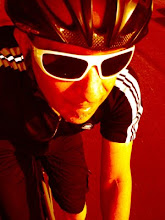Ugh, that horrible, terrible word. No one likes to think about it. The Grim Reaper, so dark and … well … grim. His huge scythe ready to take you out with one deft slice. Come on, how can he compare to Santa Claus, all merry and jolly and full of HOs.
But you know what? Riding a bike exposes us to a lot of death. Most readily present and obvious for riders to see, are the innocent victims of civilization and our non-human-powered vehicles: road kill. As cyclists, we see a lot of dead animals on our rides. We cringe and turn away from the ghastly image, hold our breath, swerve or bunny hop the ones that have been pushed to the bike lane or shoulder. I am creepily amazed by their degrees of decay and levels of flatness. Dogs, cats, squirrels, possum, skunks, birds, deer, snakes. A sad end to so many lives.
But not all creatures end dead and flat. A few months ago I was on a regular early morning ride with my friends Julia, Holt and Gordon. As we regularly do, we met at 5:20 at the Fiesta on Fulton and Quitman and headed out to the Ship Channel before turning back to downtown and then our respective homes.
On this ride we see our fair share of the dead animal world, no doubt. And riding through the poorer sections of Houston, it’s easy to encounter stray dogs and cats (although it’s a little more difficult to determine if a cat is a stray or not.) The typical stray dog encounter is also – as in that movie American Flyers – an opportunity to practice our sprint, as most strays are happy to oblige us with fierce chases.
But this one morning as we had to slow down to cross some railroad tracks, I heard a cry of what I could only describe as a combination of pity, delight, amazement and shock, as Julia spotted a small dog running at her from a field. She immediately stopped to assess the dog’s condition. Its lean body was probably due to malnutrition more than breed, though it appeared to be some sort of genetic collabo project between greyhound-whippet-jackrusselly dogs, pitbull-pointer-terrier dogs and maybe a little Chihuahua mixed in for good measure, kinda like when you thrown in a pinch of pepper in the soup, but you don’t know why. The dog was in bad shape. Shaking, with a rash on its belly, and, like I said, starving. But it had a sweet disposition, and a most crucial, life-saving skill – it had tractor-beamed itself into Julia’s soul (or maybe performed a canine version of the Jedi mind trick, who knows).
At this point in the ride, we were farthest from our start. And the ride had now officially stopped – at least as far as Julia and the puppy were concerned. The next issue on the agenda was how to transport the dog back to safety. We took a plastic bag (so hard to find, by the way) and wrapped the dog so that Julia could carry it as she rode. Yes, an admirable feat which soon proved to be unsustainable for any distance longer than 20-30 pedal strokes, even for a former bike messenger. So, after a few starts and stops we ended up at the corner of Wayside and 75th, at a small Mexican restaurant, not yet open, since it was not even 6 AM.
Julia couldn’t call her hubby Chris, because Chris had lost his phone, so she called and woke up our teammate Andrew Leach, who dutifully showed up 20 minutes later with his pick-up truck to rescue Julia, her bike, and the newly named “Flaca.” Gordon, Holt and I finished our ride, a little later than usual, but somehow faster and lighter than when we began.
At this point I’m going to give the two readers of this already-too-long story a break by fast-forwarding two days to a happily-adopted-via-Craigslist puppy who is now enjoying a pleasant life of non-flatitude somewhere in a warm home full of love.
Yes, Happy Holidays, there’s death all around us. And if we take notice of death, then we also take notice of life. And with just a little effort, people like Julia can make life happen.
Here is another version of the same story:
The Starfish Story
Once upon a time, there was a wise man who used to go to the ocean to do his writing. He had a habit of walking on the beach before he began his work.
One day, as he was walking along the shore, he looked down the beach and saw a human figure moving like a dancer. He smiled to himself at the thought of someone who would dance to the day, and so, he walked faster to catch up.
As he got closer, he noticed that the figure was that of a young man, and that what he was doing was not dancing at all. The young man was reaching down to the shore, picking up small objects, and throwing them into the ocean.
He came closer still and called out "Good morning! May I ask what it is that you are doing?"
The young man paused, looked up, and replied "Throwing starfish into the ocean."
"I must ask, then, why are you throwing starfish into the ocean?" asked the somewhat startled wise man.
To this, the young man replied, "The sun is up and the tide is going out. If I don't throw them in, they'll die."
Upon hearing this, the wise man commented, "But, young man, do you not realize that there are miles and miles of beach and there are starfish all along every mile? You can't possibly make a difference!"
At this, the young man bent down, picked up yet another starfish, and threw it into the ocean. As it met the water, he said, "It made a difference for that one."
